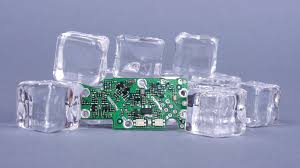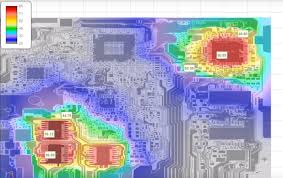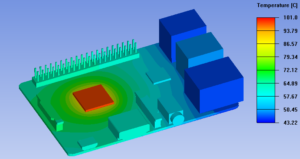The heat generated by electronic devices during operation causes the internal temperature of the device to rise rapidly. If this heat is not dissipated in a timely manner, the device will continue to warm up, the device will fail due to overheating, and the reliability of the electronic device will be decreased. Therefore, it is important to provide thermal dissipation to the board.
I. Printed Circuit Board Temperature Rise Factor Analysis The direct cause of the temperature rise of the printed circuit board is due to the presence of circuit power consumption devices, electronic devices are varying degrees of power consumption, the heat intensity varies with the size of the power consumption.
2 phenomena of temperature rise in printed boards:
(1) Localized temperature rise or large area temperature rise;
(2) Short-time temperature rise or long-time temperature rise.
When analyzing the thermal power consumption of a PCB, it is generally analyzed from the following aspects.
1. Electrical power consumption
(1) Analysis of power consumption per unit area;
(2) Analyze the distribution of power consumption on a PCB board.
2. Structure of the printed board
(1) The size of the printed board; (
)
2) the material of the printed board.
3. Printed board mounting method
(1) Mounting method (e.g. vertical mounting, horizontal mounting)
(2) Sealing condition and distance from the housing.
4. Thermal radiation
(1) Radiation coefficient of the printed board surface;
(2) the temperature difference between the printed board and the adjacent surfaces and their absolute temperatures;
5. Heat transfer
(1) Installing the heat sink;
(2) Conducting of other mounted structural members.
6. Thermal convection
(1) Natural convection;
(2) Forced cooling convection.
The analysis of each of the above factors from the PCB is an effective way to address the temperature rise of the printed circuit board, often in a product and system these factors are interrelated and dependent on each other, most factors should be analyzed based on the actual situation, only for a specific real-world situation can be more correctly calculated or estimated parameters such as temperature rise and power consumption.
II. Board Cooling Methods
1. High heat generating devices plus heat sink, thermal conductivity board
When there are a few devices in the PCB that generate a lot of heat (less than 3), heat sinks or heat pipes can be added to the heat generating devices, and when the temperature still can’t be lowered, heat sinks with fans can be used to enhance the heat dissipation. When the amount of heat-generating devices is more (more than 3), a large heat sink (board) can be used, which is customized according to the location and height of the heat-generating devices on the PCB board and a special heat sink or a large flat heat sink with different component height positions keyed in. The heat sink is snapped onto the component surface as a whole, contacting each component and dissipating heat. However, the heat sink is not effective due to the poor consistency of the height of the components when they are mounted and soldered. A soft thermal phase change pad is usually added to the component surface to improve heat dissipation.
2. Heat dissipation through the PCB itself
The widely used PCB boards today are copper-clad/epoxy glass cloth substrates or phenolic resin glass cloth substrates, with a small number of paper-based copper-clad boards in use. Although these substrates have excellent electrical properties and processability, they have poor heat dissipation and as a heat dissipation path for high heat generating components, little can be expected to be conducted by the resin of the PCB itself, but rather from the surface of the component into the surrounding air. However, as electronic products have entered the era of miniaturization of components, high density mounting, and high heat generation assembly, it is not enough to rely only on the surface area of very small components to dissipate heat. At the same time, due to the extensive use of surface mount components such as QFP and BGA, the heat generated by the components is transmitted to the PCB in large quantities, therefore, the best way to solve the heat dissipation is to improve the heat dissipation capability of the PCB itself which is in direct contact with the heat generating components, and to conduct it out or distribute it through the PCB.
3. Use reasonable alignment design to achieve heat dissipation
Because the resin in the board has poor thermal conductivity, and copper foil traces and holes are good conductors of heat, increasing copper foil residuals and adding thermally conductive holes are the primary means of dissipating heat. Evaluating the heat dissipation capability of PCBs requires calculating the equivalent thermal conductivity (nine eq) of a composite material consisting of various materials with different thermal conductivities, one by one, for insulating substrates for PCBs.
4. For devices with free convection air cooling, it is best to arrange the ICs (or other devices) in a longitudinal fashion, or in a long horizontal fashion.
5. The devices on the same printed board should be arranged in partitions according to their heat generation size and heat dissipation level as much as possible. Devices with low heat generation or poor heat resistance (such as small signal transistors, small-scale integrated circuits, electrolytic capacitors, etc.) are placed in the uppermost stream (at the entrance) of the cooling airflow, and devices with high heat generation or good heat resistance (such as power transistors, large-scale integrated circuits, etc.) are placed in the most downstream of the cooling airflow.
6. In the horizontal direction, high-power devices are placed as close as possible to the edge of the printed circuit board in order to shorten the heat transfer path; in the vertical direction, high-power devices are placed as close as possible to the top of the printed circuit board in order to reduce the impact of these devices on the temperature of other devices when working. 7. The devices that are more sensitive to temperature are best placed in the lowest temperature area (such as the bottom of the device), never place it directly above the heat generating devices, and multiple devices are best laid out in a staggered horizontal plane.
8. Heat dissipation from printed circuit boards within a device relies heavily on air flow, so it is important to study the air flow path when designing and configure the device or printed circuit board appropriately. Air flow always tends to flow where there is less resistance, so when configuring devices on the printed circuit board, avoid leaving a large open area in a certain region. The same should be noted for the configuration of multiple printed circuit boards in a complete machine.
9. Avoid the concentration of hotspots on the PCB and distribute power as evenly as possible across the PCB to maintain uniform and consistent temperature performance on the PCB surface. Often the design process is more difficult to achieve a strict uniform distribution, but be sure to avoid areas of too high power density to avoid excessive hot spots that can affect the normal operation of the entire circuit. If available, thermal efficiency analysis of the printed circuit is necessary, such as the thermal efficiency index analysis software module now added to some professional PCB design software, can help designers optimize circuit design.
10. Place the highest power and heat generating devices near the best locations for heat dissipation. Do not place devices that generate more heat in the corners and around the edges of the printed circuit board unless there is a heat sink arranged near it. When designing a power resistor, choose a larger device if possible and adjust the layout of the board to allow for adequate cooling.
11. High thermal dissipation devices should be connected to the substrate in a way that minimizes the thermal resistance between them as much as possible. To better meet the thermal characteristics, some thermally conductive material (e.g., a layer of thermally conductive silicone) can be used on the underside of the chip and a certain contact area for device heat dissipation can be maintained.
12. Device to substrate connection:
(1) Minimize device lead length;
(2) When selecting a high power consumption device, consider the thermal conductivity of the lead material and, if possible, try to select the lead with the largest cross-sectional surface;
(3) Select the device with the higher number of pins.
13. Package selection for devices:
(1) The package description of the device and its thermal conductivity should be noted when considering thermal design;
(2) Consideration should be given to providing a good thermal conduction path between the substrate and the device package;
(3) Air partitions in the heat transfer path should be avoided, and if they exist they can be filled with a thermally conductive material.
















